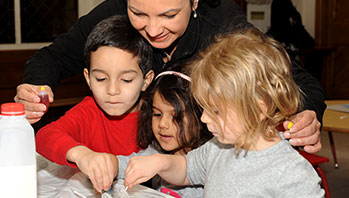- cans opened on both ends
- flexible tubing such as hoses from shop vacs, vacuum cleaners, or sump pumps
- funnels
- mailing tubes
- variety of tubes, including cardboard tubes from toilet paper, paper towels, and wrapping paper
- What Is a Scientist? (book)
- sound
- vibrate
MA Standards:
Speaking and Listening: SL.PK.MA.1a Observe and use appropriate ways of interacting in a group (e.g., taking turns in talking, listening to peers, waiting to speak until another person is finished talking, asking questions and waiting for an answer, gaining the floor in appropriate ways)
MA Draft STE Standards:
Physical Sciences/Matter and Its Interactions/PS4.B Apply their understanding in their play of how to change volume and pitch of some sounds.
Head Start Outcomes:
Logic and Reasoning/Reasoning and Problem Solving Recognizes cause and effect relationships.
Logic and Reasoning/Reasoning and Problem Solving Classifies, compares, and contrasts objects, events, and experiences.
PreK Learning Guidelines:
Science and Technology/Inquiry Skills 1 Ask and seek out answers to questions about objects and events with the assistance of interested adults.
Science and Technology/Inquiry Skills 2 Make predictions about changes in materials or objects based on past experience.
Small Group: More Tube Talk

© Commonwealth of Massachusetts, Department of Early Education and Care (Jennifer Waddell photographer). All rights reserved.
STEM Key Concepts: Sound is caused by vibration; An action has to happen to make a sound; Sounds sound different when they travel through a hollow object
ELA Focus Skills: Listening and Speaking, Fine Motor Skills, Vocabulary
Join small groups of children as they continue to explore listening and talking with tubes.
Hand a cardboard tube and a small piece of paper to each child. Have children hold the piece of paper over the end of their tube as they talk or sing into the other end. Ask children to notice what is happening to the paper. Use the word vibrate in the conversation. Then have the children breathe in and out through the tube as they feel the paper at the end of the tube. Ask questions such as,
- What is the paper doing? (wiggling, moving) Have children try singing or talking into the tube again as they feel the paper vibrate.
- What do you think is making the paper wiggle?
- Does anyone remember anything else that they could see or feel move when a sound was made? (the rubber band when it was plucked) Explain to children that both the paper and the rubber band vibrate when a sound is made.
Reflect and Share
Encourage children to share observations from their outdoor sound explorations with the tubes. Children may have different observations. If so, use it as an opportunity to revisit What Is a Scientist. Explain that scientists often have different observations, and that is why it is important that they share and discuss their observations with each other.
English Language Learners: Demonstrate the meaning of vibrate using gestures and body movements (wiggling your finger/body). Have children join in with you. Repeat the word as you demonstrate. Have children feel the paper as they repeat the word vibrate.
